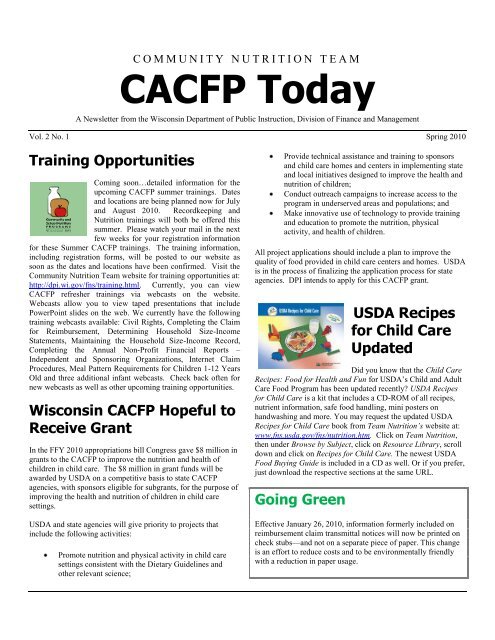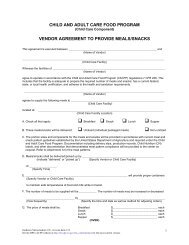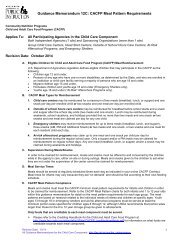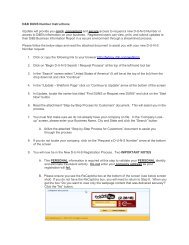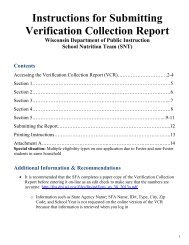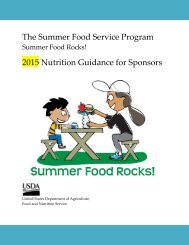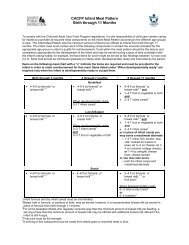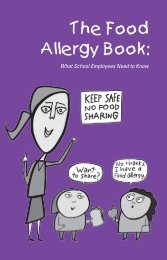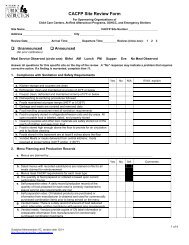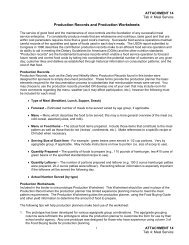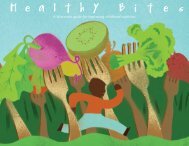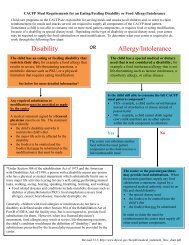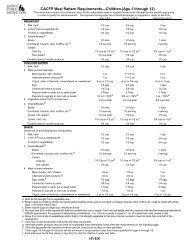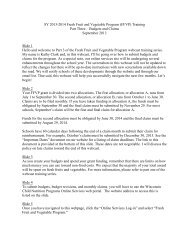Spring - WI Child Nutrition Programs (FNS)
Spring - WI Child Nutrition Programs (FNS)
Spring - WI Child Nutrition Programs (FNS)
You also want an ePaper? Increase the reach of your titles
YUMPU automatically turns print PDFs into web optimized ePapers that Google loves.
C O M M U N I T Y N U T R I T I O N T E A M<br />
CACFP Today<br />
A Newsletter from the Wisconsin Department of Public Instruction, Division of Finance and Management<br />
Vol. 2 No. 1 <strong>Spring</strong> 2010<br />
Training Opportunities<br />
Coming soon…detailed information for the<br />
upcoming CACFP summer trainings. Dates<br />
and locations are being planned now for July<br />
and August 2010. Recordkeeping and<br />
<strong>Nutrition</strong> trainings will both be offered this<br />
summer. Please watch your mail in the next<br />
few weeks for your registration information<br />
for these Summer CACFP trainings. The training information,<br />
including registration forms, will be posted to our website as<br />
soon as the dates and locations have been confirmed. Visit the<br />
Community <strong>Nutrition</strong> Team website for training opportunities at:<br />
http://dpi.wi.gov/fns/training.html. Currently, you can view<br />
CACFP refresher trainings via webcasts on the website.<br />
Webcasts allow you to view taped presentations that include<br />
PowerPoint slides on the web. We currently have the following<br />
training webcasts available: Civil Rights, Completing the Claim<br />
for Reimbursement, Determining Household Size-Income<br />
Statements, Maintaining the Household Size-Income Record,<br />
Completing the Annual Non-Profit Financial Reports –<br />
Independent and Sponsoring Organizations, Internet Claim<br />
Procedures, Meal Pattern Requirements for <strong>Child</strong>ren 1-12 Years<br />
Old and three additional infant webcasts. Check back often for<br />
new webcasts as well as other upcoming training opportunities.<br />
Wisconsin CACFP Hopeful to<br />
Receive Grant<br />
In the FFY 2010 appropriations bill Congress gave $8 million in<br />
grants to the CACFP to improve the nutrition and health of<br />
children in child care. The $8 million in grant funds will be<br />
awarded by USDA on a competitive basis to state CACFP<br />
agencies, with sponsors eligible for subgrants, for the purpose of<br />
improving the health and nutrition of children in child care<br />
settings.<br />
USDA and state agencies will give priority to projects that<br />
include the following activities:<br />
Promote nutrition and physical activity in child care<br />
settings consistent with the Dietary Guidelines and<br />
other relevant science;<br />
Provide technical assistance and training to sponsors<br />
and child care homes and centers in implementing state<br />
and local initiatives designed to improve the health and<br />
nutrition of children;<br />
Conduct outreach campaigns to increase access to the<br />
program in underserved areas and populations; and<br />
Make innovative use of technology to provide training<br />
and education to promote the nutrition, physical<br />
activity, and health of children.<br />
All project applications should include a plan to improve the<br />
quality of food provided in child care centers and homes. USDA<br />
is in the process of finalizing the application process for state<br />
agencies. DPI intends to apply for this CACFP grant.<br />
USDA Recipes<br />
for <strong>Child</strong> Care<br />
Updated<br />
Did you know that the <strong>Child</strong> Care<br />
Recipes: Food for Health and Fun for USDA’s <strong>Child</strong> and Adult<br />
Care Food Program has been updated recently? USDA Recipes<br />
for <strong>Child</strong> Care is a kit that includes a CD-ROM of all recipes,<br />
nutrient information, safe food handling, mini posters on<br />
handwashing and more. You may request the updated USDA<br />
Recipes for <strong>Child</strong> Care book from Team <strong>Nutrition</strong>’s website at:<br />
www.fns.usda.gov/fns/nutrition.htm. Click on Team <strong>Nutrition</strong>,<br />
then under Browse by Subject, click on Resource Library, scroll<br />
down and click on Recipes for <strong>Child</strong> Care. The newest USDA<br />
Food Buying Guide is included in a CD as well. Or if you prefer,<br />
just download the respective sections at the same URL.<br />
Going Green<br />
Effective January 26, 2010, information formerly included on<br />
reimbursement claim transmittal notices will now be printed on<br />
check stubs—and not on a separate piece of paper. This change<br />
is an effort to reduce costs and to be environmentally friendly<br />
with a reduction in paper usage.
CN Labels<br />
Do you know what CN Labels are? Do you know what a CN<br />
Label looks like? Let’s take a closer look at this specific label<br />
and how the use of CN Labels may benefit your food program.<br />
What is the <strong>Child</strong> <strong>Nutrition</strong> Labeling Program?<br />
The <strong>Child</strong> <strong>Nutrition</strong> (CN) Labeling Program is a voluntary<br />
USDA labeling program for the <strong>Child</strong> <strong>Nutrition</strong> <strong>Programs</strong><br />
(CNP); the <strong>Child</strong> and Adult Care Food Program is a CNP. Since<br />
it is voluntary, you will not find the CN Label on all products.<br />
The USDA evaluates a product’s formulation (exactly what the<br />
product is made from) to determine how it will contribute<br />
towards the meal pattern requirements. Once approved, the<br />
manufacturer is allowed to state this contribution on the label.<br />
What products are eligible for CN labels?<br />
Only two types of products can have CN labels; however the<br />
products may contribute to other meal components such as<br />
meat/meat alternates, bread/grains or fruits/vegetables.<br />
• Main dish products which contribute to the meat/meat<br />
alternates component of the meal pattern requirements.<br />
Examples include cheese or meat pizzas, meat/cheese and bean<br />
burritos, chicken nuggets, meat or cheese ravioli, egg rolls, beef<br />
patties, and breaded fish portions.<br />
• Juice and juice drink products containing at least 50 percent<br />
full-strength juice by volume. This includes such products as<br />
grape drink, fruit punch and frozen juice drink bars.<br />
Are CN labeled products better than similar non-CN labeled<br />
products?<br />
No, a CN Label does not indicate that the CN product is<br />
healthier or more nutritious than a similar non-CN Labeled<br />
product. It also does not indicate that the quality of the food is<br />
any different than a non-CN Labeled food. The CN label<br />
declares the quantities of the creditable food items in a processed<br />
food and how they contribute to the meal pattern requirements.<br />
What are the advantages of using CN labeled Products?<br />
• A CN label statement clearly identifies the contribution of a<br />
product toward the meal pattern requirements, and it protects<br />
you from exaggerated claims about a product.<br />
• A CN label provides a warranty against audit claims if the CN<br />
labeled product is used according to the manufacturer’s<br />
directions.<br />
• A CN label simplifies cost comparison of similar products.<br />
How do I identify a CN labeled product?<br />
Look at the sample CN label below. A CN labeled product will<br />
always contain the following:<br />
• The CN logo, which is a distinct border with CN written on all<br />
four sides<br />
• The meal pattern contribution statement<br />
• A unique six-digit product identification number (assigned by<br />
<strong>FNS</strong>) appearing in the upper right hand corner. In our example,<br />
the identification number is 000000; however, all zeroes does<br />
NOT represent a valid CN Label identification number<br />
• The USDA/Food and <strong>Nutrition</strong> Service (<strong>FNS</strong>) authorization<br />
statement<br />
• The month and year <strong>FNS</strong> gave final approval appears at the<br />
end of the authorization statement, in our example it shows<br />
09/04<br />
Beef Ravioli (Canned)<br />
CN<br />
000000*<br />
Contents of this can (108 oz) provide<br />
13.50servings (8.00 oz by weight). Each 8.00<br />
oz serving (containing 8 pies and sauce) of<br />
Beef Ravioli made with Enriched Macaroni<br />
CN Product with Fortified Protein provides 2.00 CN<br />
oz equivalent meat/meat alternate for <strong>Child</strong><br />
<strong>Nutrition</strong> Meal Pattern Requirements. (Use of<br />
this logo and statement authorized by the<br />
Food and <strong>Nutrition</strong> Service USDA 09/04)<br />
CN<br />
The beef ravioli CN label shows the can contains 13.5 servings<br />
when 2.0 ounces of meat/meat alternate are required for the<br />
lunch meal pattern. <strong>Child</strong>ren 6 to 12 years of age would need 8<br />
pies. Also, notice that 8 pies will weigh 8.0 ounces (that is a ½<br />
pound!), an ounce a piece. That also means one pie contains only<br />
¼ ounce of meat/meat alternate. How much would you have to<br />
serve for children 3 to 5 years of age? They need 1.5 ounces for<br />
lunch. If 2 ounces equals 8 pies, then 6 pies would meet the<br />
lunch meal pattern requirements for 1.5 ounces. Based on this<br />
information, would this product be an acceptable product for<br />
your child care center? The product definitely could meet the<br />
meal pattern requirements for the children. However, after<br />
reviewing this product, the size of the portions would definitely<br />
be unrealistic for the age of the children. The cost per serving<br />
may also be prohibitive since you get so few servings per can.<br />
When planning menus with combination foods, such as the beef<br />
ravioli, spaghetti and meat sauce, beef stew, or breaded chicken<br />
patty, you have to ensure each portion served meets the meal<br />
pattern requirements for lunch for the age of the children. In<br />
order to do that, you either need to 1) prepare the product from<br />
scratch using a written recipe that lists the weight of meat/meat<br />
alternate to be used, the number of portions, and serving size to<br />
meet the meal pattern requirement; or 2) if you are looking for<br />
convenience you must either purchase a CN Labeled product or<br />
request a product formulation sheet or product analysis sheet<br />
signed by an official of the manufacturer (not a salesperson)<br />
stating the amount of meat/meat alternate in the product. Call<br />
the 1-800 number on the package and ask for a manufacturer’s<br />
analysis sheet. This will provide the same information as a CN<br />
label.<br />
USDA Memos<br />
Recently issued Guidance Memos from USDA include:<br />
Memo No. Title<br />
07-2010 Eligibility of Haitian Refugees for the <strong>Child</strong> <strong>Nutrition</strong><br />
<strong>Programs</strong><br />
A link to the memos can be found on our website under USDA<br />
CACFP Policy Memos at: http://dpi.wi.gov/fns/cacfp1.html<br />
2 CACFP Today
Mealtime<br />
Memo<br />
Mealtime Memo for<br />
<strong>Child</strong> Care is a<br />
Newsletter for child care<br />
providers participating in the CACFP, focused on good nutrition<br />
for young children. The National Food Service Management<br />
Institute (NFSMI), University of Mississippi publishes Mealtime<br />
Memos monthly on their website:<br />
http://www.nfsmi.org/Default.aspx, in the resource center<br />
section. Your agency can sign up to receive Mealtime Memos<br />
by email thru the NFSMI website. Check out this recent edition,<br />
Accommodating Vegetarian Diets, learn how minor adjustments<br />
to recipes and menus can still meet vegetarian children's<br />
nutritional needs. This edition includes a recipe for egg salad<br />
sandwiches and a week of sample menus,<br />
http://www.nfsmi.org/documentlibraryfiles/PDF/201003010947<br />
43.pdf<br />
Meat and Meat Alternates on<br />
the CACFP<br />
While the meat and meat alternates are but one component in the<br />
<strong>Child</strong> and Adult Care Food Program meal pattern the food group<br />
is important in providing protein, iron, zinc, B vitamins (thiamin<br />
riboflavin, niacin, B23) and other nutrients. While some items<br />
are higher in iron, like red meats and other animal products, they<br />
all contain protein.<br />
Here are some reminders when planning and serving the items<br />
from the meat/meat alternate food group in your meals and<br />
snacks. Amounts are the issue when serving meat or meat<br />
alternates.<br />
When peanut or nut butter sandwiches are included in a lunch or<br />
supper, a second meat or meat alternate is necessary to supply<br />
the required amount for the meal pattern requirement. WHY?<br />
Two (2) tablespoons of Peanut butter to ½ slice of bread are<br />
needed for a 1-2 year old. Three (3) tablespoons of Peanut<br />
butter to ½ slice of bread are needed for a 3-5 year old, and<br />
Four (4) tablespoons or ¼ cup of Peanut butter to 1 slice of<br />
bread are needed for the 6-12 year olds. This is way too much<br />
peanut butter on a sandwich to be safe for any of the age groups.<br />
Grilled cheese sandwiches are another item often seen on menus<br />
served at lunch or supper time at child care centers on the<br />
CACFP that may need an additional meat or meat alternate<br />
added to the meal. The amount of cheese required for the<br />
CACFP meal pattern is 1 to 2 ounces depending on the age<br />
grouping. Cheese slices, such as American cheese, are most<br />
often packaged in ¾ ounce serving sizes. Grilled cheese meal<br />
preparations observed frequently have only 1 slice (or ¾ ounce)<br />
of cheese on 2 slices of bread. This is not enough cheese to meet<br />
any of the age category requirements.<br />
If the slice of cheese is ¾ ounce then<br />
1-2 year will need 1 and 1/3 slice cheese<br />
3-5 year olds will need 2 slices of cheese<br />
6-12 year olds will need 2 and 2/3 slices of cheese<br />
Yogurt is another item included in the meat alternate food<br />
category for the <strong>Child</strong> and Adult Care Food Program. Yogurt<br />
can often be included as the additional protein in a meal that<br />
needs more protein like the peanut butter sandwich or grilled<br />
cheese sandwich. However, when served as the only meat/meat<br />
alternate component in a lunch or dinner, the serving size must<br />
be ½ cup for 1-2 year olds; ¾ cup for 3-5 year olds and 1 full 8<br />
ounce cup for 6-12 year olds to meet meal pattern requirements.<br />
A legume dish can be easily included in a meal to stand alone or<br />
enhance the quantity of meat or meat alternate. What is a<br />
legume? Legumes are plants of the pea or pod family, including<br />
peas, beans and lentils. They are rich in fiber and protein.<br />
Legumes are in the meat/meat alternate food group as well as the<br />
fruit/vegetable group on the CACFP (can’t be counted as a meat<br />
alternate and vegetable in the same meal). Remember, 10-20<br />
tries for a new food to become familiar!<br />
Here are some menu ideas:<br />
Peanut butter sandwiches<br />
Cottage cheese and Peaches<br />
Green Beans<br />
Milk<br />
Grilled Cheese sandwich<br />
Yogurt and Grapes<br />
Carrots<br />
Milk<br />
Bean burrito D-21A 1<br />
Sweet Potato Fries<br />
Milk<br />
1 USDA Recipes for <strong>Child</strong> Care<br />
Welcome New Agencies<br />
Little Prints Daycare LLC, Lancaster<br />
Wisconsin Starz Academy, Kenosha<br />
Celebration <strong>Child</strong>ren’s Center, Appleton<br />
Kurtenbach Investments LLC, Chippewa Falls<br />
Rising Star Learning Academy, Milwaukee<br />
Babes in Toyland, Eau Claire<br />
Amy’s Academy LLC, Greenfield<br />
Grins & Giggles <strong>Child</strong>care LLC, Middleton<br />
Central Clark Cty Community CCC, Greenwood<br />
Learn & Grow Preschool & <strong>Child</strong>care, Rice Lake<br />
Calvary Daycare, West Bend<br />
Amy’s Academy Lake Geneva LLC, Lake Geneva<br />
Living in Destiny Daycare, Milwaukee<br />
Milwaukee Public School District, Milwaukee<br />
CACFP Today 3
Division for Finance &<br />
Management<br />
Community <strong>Nutrition</strong> <strong>Programs</strong> FAX . . (608) 267-0363<br />
Community <strong>Nutrition</strong> Team<br />
Ellen Sullivan, Interim Director . . . . . . . . (608) 267-1070<br />
Amy Kolano, RD, CD, Coordinator,<br />
Summer Food Service Program . . . . . . . . . (608) 266-7124<br />
Ellen Sullivan, RD, MS, CD<br />
Team Leader . . . . . . . . . . . . . . . . . . . . . . . (608) 267-1070<br />
Cari Ann Muggenburg, Auditor-Senior. . . (608) 264-9551<br />
Barb Douglas, Office Operations Associate. (608) 267-9129<br />
<strong>Nutrition</strong> Program Consultants<br />
Lisa Calderone . . . . . . . . . . . . . . . . . . . . . . (608) 266-5763<br />
Renee Drake . . . . . . . . . . . . . . . . . . . . . . . . (608) 266-3874<br />
Kim Musiedlak . . . . . . . . . . . . . . . . . . . . . (608) 264-9542<br />
Monica Owsichek, RD, CD . . . . . . . . . . . . (608) 267-2373<br />
Moryah Becker, RD . . . . . . . . . . . . . . . . . (608) 266-9982<br />
Molle Polzin, RD, CD . . . . . . . . . . . . . . . . (608) 267-9210<br />
Mike Ryan . . . . . . . . . . . . . . . . . . . . . . . . . (608) 267-9130<br />
Jill Schneeberg . . . . . . . . . . . . . . . . . . . . . . (608) 261-6334<br />
Federal Aids and Audit Fiscal Unit<br />
Federal Aids and Audit FAX . . . . . . . . . . . . (608) 267-9207<br />
Jacque Jordee, Financial Specialist . . . . . . . (608) 267-9134<br />
Angie Moen, Financial Specialist . . . . . . . . (608) 267-9196<br />
Home Page<br />
http://dpi.wi.gov/fns<br />
The Wisconsin Department of Public Instruction does not discriminate<br />
on the basis of sex, race, color, religion, creed, age, national origin,<br />
ancestry, pregnancy, marital status or parental status, sexual orientation,<br />
or disability.<br />
In accordance with Federal law and the U.S. Department of Agriculture<br />
policy, this institution is prohibited from discriminating on the basis of<br />
race, color, national origin, sex, age, or disability. To file a complaint<br />
of discrimination, write USDA, Director, Office of Civil Rights, 1400<br />
Independence Avenue, S.W., Washington, DC 20250-9410 or call<br />
((800) 795-3272 or (202) 720-6382 (TTY). USDA is an equal<br />
opportunity provider and employer.<br />
CACFP Today<br />
is published quarterly by the Department of Public Instruction.<br />
Questions or comments should be directed to:<br />
Kimberly Musiedlak<br />
<strong>Nutrition</strong> Program Consultant<br />
Wisconsin Department of Public Instruction<br />
P. O. Box 7841<br />
Madison, <strong>WI</strong> 53707-7841<br />
608-264-9542 or 1-800-441-4563<br />
Kimberly.Musiedlak@dpi.wi.gov<br />
www.dpi.wi.gov/fns<br />
Printed on Recycled Paper<br />
April 2010<br />
Sun Mon Tue Wed Thu Fri Sat<br />
1 2 3<br />
4 5 6 7 8 9 10<br />
11 12 13 14 15 16 17<br />
Claim<br />
Due 2<br />
National Library Week<br />
April 11 - 17<br />
18 19 20 21 22 23 24<br />
Earth<br />
Day<br />
25 26 27 28 29 30<br />
May 2010<br />
Sun Mon Tue Wed Thu Fri Sat<br />
1<br />
2 3 4 5 6 7 8<br />
National Family Week<br />
May 2 - 8<br />
9 10 11 12 13 14 15<br />
Mother’s<br />
Day<br />
Claim<br />
Due 2<br />
16 17 18 19 20 21 22<br />
23 24 25 26 27 *28 29<br />
Furlough<br />
Day<br />
30 *31<br />
Memorial<br />
Day<br />
June 2010<br />
Sun Mon Tue Wed Thu Fri Sat<br />
June is Dairy 1 2 3 4 5<br />
Month<br />
www.nationaldair<br />
Qtrly<br />
NPFS<br />
ycouncil.org Report 1<br />
Due<br />
6 7 8 9 10 11 12<br />
Father’s<br />
Day<br />
13 14 15 16 17 18 19<br />
Claim<br />
Due 2<br />
20 21 22 23 24 25 26<br />
Home<br />
Sponsor<br />
Training<br />
27 28 29 30<br />
1 Qtrly NPFS - Quarterly Nonprofit Food Service (Report Due for<br />
Sponsors of more than 1 site only)<br />
2 Claim Due - CACFP reimbursement claim is suggested to be submitted<br />
by the 15 th of the following month of the claim month. Claims will be<br />
accepted if submitted within 60 days after the end of the claim month.<br />
* DPI State Offices Closed<br />
All of the CACFP Newsletters are available electronically on our<br />
website at: http://dpi.wi.gov/fns/newsltrcnt.html.


